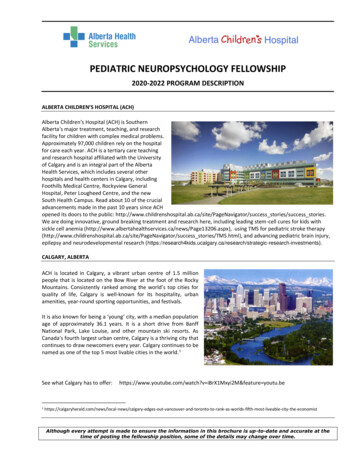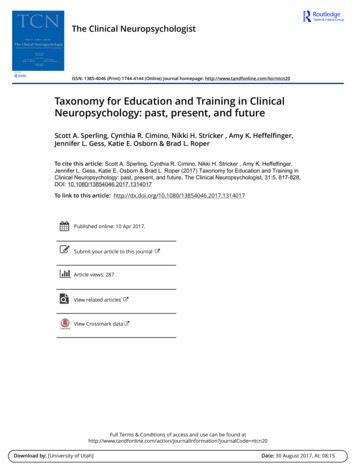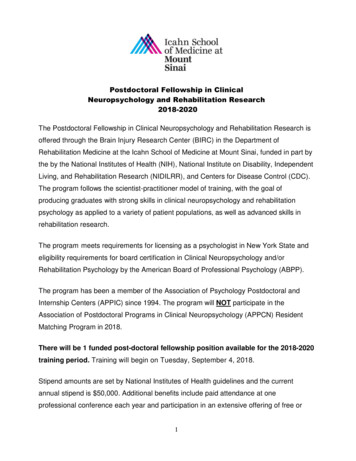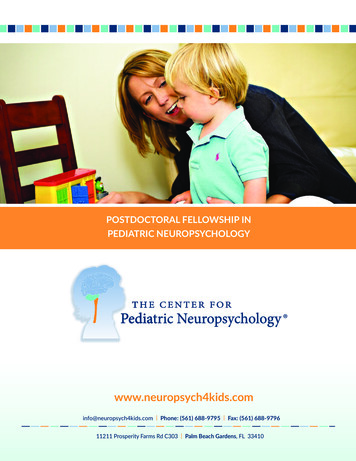
Transcription
Encyclopedia of ClinicalNeuropsychology
Jeffrey S. Kreutzer John DeLucaBruce CaplanEditorsEncyclopedia of ClinicalNeuropsychologySecond EditionWith 230 Figures and 197 Tables
EditorsJeffrey S. KreutzerDepartment of PhysicalMedicine and RehabilitationVirginia Commonwealth UniversityRichmond, VA, USAJohn DeLucaKessler FoundationPleasant Valley WayWest Orange, NJ, USABruce CaplanIndependent PracticeWynnewood, PA, USAISBN 978-3-319-57110-2ISBN 978-3-319-57111-9 (eBook)ISBN 978-3-319-57112-6 (print and electronic brary of Congress Control Number: 2018945469# Springer Science Business Media, LLC 2011# Springer International Publishing AG, part of Springer Nature 2018This work is subject to copyright. All rights are reserved by the Publisher, whether the whole orpart of the material is concerned, specifically the rights of translation, reprinting, reuse ofillustrations, recitation, broadcasting, reproduction on microfilms or in any other physical way,and transmission or information storage and retrieval, electronic adaptation, computer software, orby similar or dissimilar methodology now known or hereafter developed.The use of general descriptive names, registered names, trademarks, service marks, etc. in thispublication does not imply, even in the absence of a specific statement, that such names are exemptfrom the relevant protective laws and regulations and therefore free for general use.The publisher, the authors, and the editors are safe to assume that the advice and information in thisbook are believed to be true and accurate at the date of publication. Neither the publisher nor theauthors or the editors give a warranty, express or implied, with respect to the material containedherein or for any errors or omissions that may have been made. The publisher remains neutral withregard to jurisdictional claims in published maps and institutional affiliations.This Springer imprint is published by Springer Nature, under the registered company SpringerInternational Publishing AGThe registered company address is: Gewerbestrasse 11, 6330 Cham, Switzerland
PrefaceNeuropsychology is a rapidly evolving field with inspiring advances inneurotechnology, assessment, and intervention occurring regularly. An act oflabor and love, the conceptualization, compilation, and production of theEncyclopedia of Clinical Neuropsychology (2nd ed.) spanned more than4 years. Building on the foundation of the first edition, the editors-in-chiefsought to provide a current corpus of content of empirically based, relevant,and practical information. To this end, we added three new topical sections:neuroimaging, military neuropsychology, and DSM-5 and enlisted the help ofthree superb new section editors: Erin Bigler, Ph.D., Risa Nakase-Richardson,Ph.D., and Ana Mills, Psy.D, respectively, to orchestrate the new sections. Animmense project, the encyclopedia now contains more than 2,200 entries.More than 1,600 first edition entries were updated and 230 new entries wereadded. The newest edition of the encyclopedia now reflects the work of nearly900 authors.As with the first edition, we have aimed to create a comprehensive referencefor professionals involved in the evaluation, diagnosis, and rehabilitation ofchildren and adults with neurological disorders. We have also provided students and researchers with the breadth of knowledge to facilitate success inevaluating and treating these patients. Suggested readings and cross referencesdirect readers to additional information on the various topics. We anticipatethat the Encyclopedia of Clinical Neuropsychology will be the first placereaders turn for factual, relevant, and comprehensive information.August 2018Jeffrey S. KreutzerJohn DeLucaBruce Caplanv
AcknowledgmentWe are indebted to our cadre of esteemed Associate Editors for helping todevelop their sections, recruit contributors, and ensure the presence of consistently high quality entries. We express our utmost appreciation to the brilliantgroup of authors whose efforts form the core of our project. We are immenselyindebted to the superb Springer Major reference works team including JaniceStern, Michael Hermann, and Sonja Peterson. They taught us, encouraged us,kept us organized and on track, and helped us in every step of the way. We arealso grateful to our students, patients and their families from whom we learnedmuch about facing challenges and the value of being practical.vii
List of TopicsCancer and Tumors–Bruce CaplanSection Editor: Carol L. ArmstrongAcoustic NeuromaAcute Lymphoblastic LeukemiaAcute Myelogenous LeukemiaAcute Radiation SomnolenceAdenomaAngioma, Cavernous AngiomaAstrocytomaAtypical Teratoid/Rhabdoid Tumor (AT/RT)BiopsyBrachytherapyBrain TumorBrainstem GliomaCentigrayCerebellar MutismChemotherapyCognitive Affective SyndromeCraniopharyngiomaCraniospinal RadiotherapyCystDesmoplastic GangliocytomaDysembryoplastic Neuroepithelial TumorEarly-Delayed Effects of RadiationEndothelial ProliferationEpendymomaEwing’s SarcomaFibrillary AstrocytomaGangliogliomaGerm Cell TumorsGlioblastoma MultiformeGliomaGliomatosis pericytomaHygromaHypothalamic GliomaIntensity-Modulated Radiation TherapyInvolved Field RadiotherapyLate-Delayed Effects of Radiation TherapyLate Effects of Radiation TherapyLeukemiaLymphoplasmacytic TumorMeninges Type urocytomaNeurofibromatosis Type 1 (NF1)Neurofibromatosis Type 2 (NF2)NeuromaOligoastrocytomaOligodendrogliomaOptic Glioma, Optic Pathway GliomaPilocytic Astrocytoma and Juvenile PilocyticAstrocytomaPineal TumorsPituitary AdenomaPituitary MassPlasmacytomaPleomorphic, PleomorphismPlexiform NeurofibromaPosterior FossaPosterior Fossa Syndromeix
xPrimitive Neuroectodermal TumorProton Beam TherapyRadiation InjuryRadiation NecrosisRadiation OncologyRadiosurgery, Stereotactic actic Radiation TherapyTectal GliomaTeratomaTuberous SclerosisTumor GradeXanthoastrocytomaBacterial VentriculitisChemo BrainDysmetriaEpigeneticsEyeblink ConditioningIntraoperative hologyTranscranial Electrical Stimulation (tES)Forensics–Jeff KreutzerSection Editor: Julie K. LynchAACN Practice GuidelinesActus ReusAdmissibilityAggravating FactorsAmericans with Disabilities Act of 1990ArbitrationAtkins v. VirginiaAttorneyBarefoot v. Estelle (1983)Baxter v. Temple (2005)Beyond a Reasonable DoubtBiasBurden of ProofCapacityChandler Exterminators v. Morris (1992)Chapple v. GangerCivil LitigationClear and Convincing EvidenceList of TopicsCompetencyConfidentialityCriminal ForensicsCriminal LitigationCriminal ResponsibilityCross-ExaminationDaubert v. Merrell Dow Pharmaceuticals (1993)Death PenaltyDepositionDetroit Edison v. NLRB (1979)Diminished CapacityDiminished ResponsibilityDirect ExaminationDiscoveryDissimulationDue ProcessDusky v. United States (1960)Estelle v. Smith (1981)Ethical Principles in ForensicsExpert v. Treater RoleExpert WitnessFake Bad ScaleFederal Rules of Civil Procedure 26 and 35Federal Rules of Criminal ProceduresEmphasizing 12.2Federal Rules of EvidenceFinancial CapacityFord v. WainwrightForensic NeuropsychologistForensic NeuropsychologyForensic PsychologyFRE 104, 403, 702, and 704Frontal Lobe DefenseFurman v. Georgia (1972)Guilty But Mentally IIIHare Psychopathy ChecklistHearsay EvidenceIn Camera ReviewIndependent Medical EvaluationIndependent Neuropsychological ExaminationInformed ConsentInsanityInsanity DefenseIntent, General v. SpecificIrresistible ImpulseJenkins v. U.S. (1962)Joiner v. General Electric (1997)Kumho Tire v. Carmichael
List of TopicsLearned TreatiseLegal CompetencyLitigationLockett v. Ohio (1978)M’Naghten RuleMalingeringMediationMedical MalpracticeMens ReaMental State at OffenseMiranda v. ArizonaMitigating FactorsMotion for Summary JudgmentMotion in LiminePenry v. Lynaugh (1989)Personal InjuryPreponderance of the EvidencePrima Facie CasePrivilegeProximate CauseSection 504 of the Rehabilitation Act of 1973Self-IncriminationSpecialty Guidelines for Forensic PsychologyStructured Interview of Reported Symptoms(SIRS)SubpoenaSubpoena Duces TecumTestamentary CapacityTestifying Expert Versus Fact WitnessThird Party ObserverTrial ConsultingVoir DireWorkers’ CompensationPediatrics–Bruce CaplanSection Editor: Jennifer Ann Niskala Apps504 PlanAAMD Adaptive Behavior ScalesAbsence EpilepsyAccommodationsAdaptive Behavior Assessment System: ThirdEditionAnencephalyAngelman SyndromeApplied Behavior AnalysisAsperger’s DisorderxiAssistive TechnologyAttention Deficit Hyperactivity DisorderAugmentative and Alternative Communication(AAC)Autism Diagnostic Interview, RevisedAutism Diagnostic Observation ScheduleAutistic DisorderBayley Scales of Infant and Toddler DevelopmentBeery Developmental Test of Visual-MotorIntegration (VMI), Sixth EditionBASC-3Rolandic EpilepsyCalifornia Verbal Learning Test – Children’sVersionCentral Auditory Processing DisorderCerebral PalsyAchenbach System of Empirically BasedAssessment (ASEBA)Childhood Autism Rating ScalesChildren’s Category TestChildren’s Memory ScaleConners 3rd Edition (Conners 3; Conners 2008)Conners Comprehensive Behavior RatingScales Conners’ Continuous Performance Test ThirdEditionDelis-Kaplan Executive Functioning SystemDevelopmental Gerstmann SyndromeDifferential Ability Scales (DAS and DAS-II)Down SyndromeDyslexiaExpressive One-Word Picture Vocabulary TestFamily-Centered CareFebrile SeizuresFetal Alcohol Spectrum DisorderFragile X SyndromeFunctional Independence Measure for ChildrenGeneral Language CompositeHeterotopiaHuman Figure Drawing TestsHyperlexiaIndividuals with Disabilities Education ActIntellectual DisabilityJuvenile Huntington DiseaseJuvenile Myoclonic EpilepsyJuvenile Parkinson’s DiseaseLandau-Kleffner SyndromeLearning Disability
xiiLeiter International Performance Scale, ThirdEditionLennox-Gastaut SyndromeMegalencephalyMicrocephalyMinimal Brain DysfunctionModified Checklist for Autism in Toddlers,Revised, with Follow-Up (M-CHAT-R/F), alsoM-CHATMullen Scales of Early LearningMyelomeningoceleMyoclonic Epilepsy in InfancyNational Dissemination Center for Children withDisabilitiesNational Organization for Rare Disorders(NORD)NEPSY-IINo Child Left Behind Act of 2001Nonverbal Learning DisabilitiesPeabody Individual Achievement Test, RevisedPeabody Picture Vocabulary TestPerceptual Reasoning IndexPeriventricular LeukomalaciaPersonality Inventory for ChildrenPervasive Developmental Disorder NOSPhenylketonuriaPlasticityPrader-Willi SyndromePrematurity and Low Birth WeightProcessing Speed Index (WPPSI-IV)Public Law 94-142Semantic Pragmatic Disorder (SPD)Sensitive PeriodsAbusive Head TraumaSoft SignsStanford-Binet Intelligence Scales and RevisedVersionsStroop Color and Word Test, Children’s VersionTEACCHTourette SyndromeTurner SyndromeVineland Adaptive Behavior ScalesVineland Social Maturity ScalesWaisman Center, University of WisconsinMadisonWechsler Intelligence Scale for ChildrenWechsler Preschool and Primary Scale ofIntelligenceList of TopicsWest SyndromeWilliams SyndromeContinuous Auditory Test of Attention(CATA)Duplication 7 SyndromeMovement–Jeff KreutzerSection Editor: Douglas I. KatzAbasiaAction basiaAtaxiaAutomatismBalance DisordersBell’s ed DyskinesiaDysdiadochokinesiaDystoniaEssential TremorFestinationGait pertrophyIntention TremorsInternal CapsuleInternuclear OphthalmoplegiaLateral Gaze PalsyLeukodystophyLocked-In SyndromeMagnetic GaitMasked FaciesMénière’s SyndromeMicrographiaMotor StereotypyMovement DisordersMyoclonus
List of TopicsOrthostatic TremorParkinson Plus SyndromesParkinsonismPhysiologic TremorPtosisRestless Leg SyndromeRetropulsionRigiditySpastic GaitTardive DyskinesiaThalamusTicTremorWilson’s DiseaseMedical–Jeff KreutzerSection Editor: Nathan D. ZaslerAbbreviated Injury ScaleAblationAlpha RhythmAngiography, CerebralBabinski ReflexBlood Alcohol LevelBlood Flow StudiesBlood Oxygen Level Dependent (BOLD)Brainstem Auditory Evoked ResponsesCarotid AngiographyCarotid EndarterectomyCommissurotomyComputed TomographyCoronary Artery Bypass GraftCranioplastyCraniotomyDeep Brain Stimulator (Parkinson’s)Diffusion Tensor ImagingDigital Subtraction AngiographyDoppler UltrasoundDysconjugate heal TubeEvent-Related PotentialsEvidence-Based PracticeEvoked PotentialsFixed PupilsxiiiFluorodeoxyglucose Positron EmissionTomographyFractional AnisotropyFrontal LobotomyFunctional ImagingGamma KnifeHemispherectomyHemodynamic ResponseHemoglobinInternational Classification of DiseasesIntracarotid Sodium Amobarbital TestLeukotomyLobectomyLumbar PunctureLuxury PerfusionMagnetic Resonance AngiographyMagnetic Resonance ImagingMagnetic Resonance SpectroscopyMagnetoencephalographyMidline ShiftNeuroimagingNeurologic ExaminationNuclear Magnetic ResonanceOlfactionP300PallidotomyPETPhysiatric -traumatic HeadachePosturographyPrefrontal LobotomyQuantitative EncephalographyRadiotherapyRancho Los Amigos ScaleRegional Cerebral Blood FlowSensorimotor AssessmentShuntsSignsSingle Photon Emission Computed TomographySomatosensory Evoked PotentialsStereotaxic SurgeryTemporal LobectomyTeslaTranscranial DopplerTranscranial Magnetic StimulationUBO
xivVentriculostomyVisual Evoked PotentialsVoxelWada TestAcademic Evaluation–John DelucaSection Editor: Rik Carl D’AmatoAbstract ReasoningAcademic CompetencyAcademic SkillsAcalculiaArithmetic ReasoningAuditory DiscriminationAuditory ProcessingSocial AwarenessBasic Achievement Skills InventoryBender Visual-Motor Gestalt Test IICognitive Assessment SystemCompensatory Education ApproachConstructional ApraxiaDeaf/Hearing ImpairmentDean-Woodcock NeuropsychologicalAssessment SystemDevelopmental Milestones, StagesDyscalculiaEducational TestingEmotional DisturbanceEmotional IntelligenceEmotionalityExecutive FunctioningFinger LocalizationIndividual Education ProgramMainstreamingManual DexterityManual StrengthMcCarthy Scales of Children’s AbilitiesMental TrackingMetacognitionMultitaskingNational Adult Reading Test and Orientation(Left–Right)OrientationOrientation (Left-Right)Other Health ImpairmentOtis-Lennon School Ability TestPhonemic AwarenessList of TopicsPhonicsPhysical DisabilitiesPraxisPrimary Handicapping ConditionsProblem SolvingProprioceptionRapid Automatic NamingReadingReading ComprehensionReading FluencyReality OrientationReasoningRemedial Education ApproachResponse to InterventionScholastic Aptitude TestSecondary Handicapping ConditionSelf-RegulationSequential ProcessingSimultaneous ProcessingSocial CompetenceSpecial EducationSpeech/Communication DisabilitiesStereognosisStrength-Based EducationTests of General Educational DevelopmentVocabularyWechsler Individual Achievement TestWechsler Test of Adult ReadingWoodcock-Johnson IVProgress MonitoringNeuropsychologically Driven InterventionsEvidence-Based InterventionsSingle-Case Design InterventionsInclusive EducationHomeschooling (HomeschoolEducation)Charter eurotechnologyNeurosystemsImmigrant LanguagesPsychoeducationEducationPreventionFamily EducationNeurotherapy
List of TopicsNeurofeedbackMindfulnessInfant/Toddler Preschool Assessment (0–6)Attention and Concentration–John DelucaSection Editor: Ronald Cohen and Adam J.WoodsAction-Intentional DisordersAnosognosiaAnterior Cingulate CortexArousalAttentionAttention Network Test (ANT)AutomaticityCalifornia Computerized Assessment PackageCancellation TestsCapacity LimitationsCatatonic BehaviorConfabulationConners Rating ScalesConsciousnessContinuous Performance TestsControlled AttentionCue DominanceDefault NetworkDeliriumDelusionDichotic ListeningDigit SpanDigit Symbol Substitution TestDirected AttentionDiscriminabilityDisengagement of AttentionDisinhibitionDivided lteringFocused rior Parietal LobuleInformation Processing SpeedxvInspection TimeInterferenceLethargyN-Back ParadigmOrienting ResponsePaced Auditory Serial Attention TestParallel ProcessingProcessing Speed IndexSearchlight HypothesisSelective Attention ModelsSerial SevensSerial/Sequential ProcessingSignal Detection TheorySpan of ApprehensionSustained AttentionSymbol SearchTest of Everyday AttentionTest of Everyday Attention for ChildrenThalamic GatingVigilanceWorking MemoryYerkes-Dodson LawAttentional Response BiasEye TrackingFlanker TaskD2 Test of AttentionDigit Vigilance TestBrief Test of AttentionTests of Variables of AttentionAuditory Selective Attention TestVisual Search and Attention TestAttentional BlinkVertical NeglectUseful Field of View (UFOV)Behavioral Inattention Test (BIT)Visual SearchTroxler FadingPrimingPre-Pulse InhibitionInattentional BlindnessBrain Injury–Jeff KreutzerSection Editor: James F. MalecAcceleration InjuryAcute Respiratory Distress SyndromeAppalic Syndrome
xviAutomated Neuropsychological AssessmentMetricsBattle’s SignBiomechanics of InjuryBlast InjuryBrain SwellingComaConcussionContrecoup InjuryCortical ContusionCraniectomyDeceleration InjuryDecerebrate PosturingDecorticate PosturingDepressed Skull FractureDiffuse Axonal InjuryDistractibilityEdemaElectrical Brain InjuryEmbolismEpidemiologyEpidural HematomaFatigueFocal Lesion, ContusionHead InjuryHeterotopic OssificationHolistic Brain Injury RehabilitationHypersomniaHypoarousalImmediate Post-Concussion Assessment andCognitive TestingImpaired Self-AwarenessInitiationInsomniaLead ExposureLoss of ConsciousnessMass EffectMemory ImpairmentMercury ExposureMild Traumatic Brain InjuryMinimally Conscious StateMinimally Responsive StateModerate Brain InjuryNarcolepsyObstructive Sleep Apnea SyndromeOccult Head InjuryOutcome, Outcome MeasurementPediatric Traumatic Brain InjuryList of TopicsPenetrating TBIPneumothoraxPolytraumaPostacute Brain Injury RehabilitationPostconcussion SyndromePost-traumatic Confusional StatePupillary Light Response, Pupillary ResponseRaccoon EyesRotational AccelerationSecondary Brain InjurySevere Brain InjuryShearing Injury, Shear StrainSkull FractureSleep Apnea SyndromeSleep DisturbanceSpinal Cord InjurySport-Related ConcussionStuporSubgaleal HematomaTime to Follow CommandsToxic ExposureTrauma CenterTraumatic Brain Injury (TBI)Traumatic Brain Injury Model SystemVegetative State (Persistent)WhiplashOhio State University Traumatic Brain InjuryIdentification MethodNormal Pressure HydrocephalusCNS–John DelucaSection Editor: Randall E. Merchant and JohnDeLucaAfferentAlzheimer’s DiseaseAmygdalaArcuate FasciculusAssociational FibersAuditory PathwayAutonomic Nervous SystemBasal ForebrainBasal GangliaBlood-Brain BarrierBrain DeathBrodmann’s Areas of the CortexCaudate Nucleus
List of TopicsCerebellumCerebral CortexCerebral EdemaCerebral Perfusion PressureCommissures, CerebralCorpus CallosumCortical Motor PathwaysCortical-Subcortical LoopCranial NervesDentate GyrusDiencephalonEfferentVisual FieldsForebrainFornixFrontal LobeGanglionGlobus PallidusGray MatterHemi-attention SyndromeHindbrainHydrocephalusInsular LobeIntracranial PressureKorsakoff’s SyndromeLimbic SystemLocalizationLocus CeruleusMediodorsal Nucleus of ThalamusMedullaMedulloblastomaMeningesMesolimbic Dopaminergic ProjectionsMidbrainMidbrain RapheMultiple SclerosisMyelinNeocortexNeurogliaNeuronNucleus AccumbensNucleus Basalis of MeynertOccipital LobePallidumPapez CircuitParietal LobeParkinson’s DiseasePeriventricular White MatterxviiPneumocephalusPonsPostcentral GyrusPrecentral GyrusPutamenPyramidal SystemRaphe NucleusReticular Activating SystemRostralSomatosensory SystemSpinal CordStriate CortexStriatumSubfornical OrganSubiculumSubstantia NigraSuperior ColliculusSuperior Longitudinal FasciculusSupramarginal GyrusSylvian FissureTemporal LobeUncusVentral Tegmental Area of MidbrainVentriclesVentricular EnlargementVestibular NucleiVisual CortexWhite MatterCaudalSchizophreniaCognitive Rehabilitation–John DelucaSection Editor: Sarah A. RaskinActive Limb ActivationActivities of Daily Living (ADL)Attention TrainingCognitive CorrectorsCognitive FunctioningCognitive RehabilitationCompensatory StrategiesConcept LearningConstraint Induced TherapyError Recognition and CorrectionErrorless LearningInsight: Effects on RehabilitationLighthouse Technique
xviiiMemory BookMethod of Vanishing CuesMnemonic TechniquesNeuropsychological RehabilitationProcess TrainingProsthetic Memory AidsQuality of LifeStrategy SubstitutionVerbal MediationComputerized TreatmentGoal Management TrainingAcademic TechniquesBrain TrainingDementia–John DelucaSection Editor: Gordon CheluneAlzheimer’s DementiaAmyloid PlaquesAmyotrophic Lateral r’s DiseaseBlessed Dementia ScaleCADASILCholinesterase InhibitorsClinical Dementia RatingConsortium to Establish a Registry onAlzheimer’s DiseaseCorticobasal DegenerationDementia Rating Scale-2Dementia with Lewy BodiesDemyelinationEncephalopathyFrontal Temporal DementiaFrontotemporal Lobar DegenerationsGliosisHuntington’s DiseaseHypertensive EncephalopathyLeukoaraiosisLewy BodiesLogopenic AphasiaMetabolic EncephalopathyMild Cognitive ImpairmentModified Mini-Mental State ExaminationMulti-infarct DementiaList of TopicsNeurofibrillary TanglesOptic NeuropathyParalysis AgitansParkinson’s DementiaPick’s DiseasePrimary Progressive Multiple SclerosisProgressive AphasiaProgressive Supranuclear PalsyRelapsing-Remitting Multiple SclerosisSecondary-Progressive Multiple SclerosisSemantic DementiaSenile DementiaSenile PlaquesSmall Vessel Ischemic DiseaseTauopathyVascular Cognitive ImpairmentVascular DementiaFrontal Lobe–John DelucaSection Editor: Paul MalloyAbuliaAdynamiaAkinetic MutismAlien Hand SyndromeAnosmiaApathyAvolitionBehavior Rating Inventory for ExecutiveFunctionCategory TestCentral ExecutiveCingulate GyrusCingulumDelayed Response TasksDesign Fluency TestDorsolateral Prefrontal CortexEnvironmental DependencyExecutive Abilities: Methods and Instruments forNeurobehavioral Evaluation and ResearchExecutive InterviewFigural Fluency TestFrontal Systems Behavior ScaleGegenhaltenGlabellar ReflexGrasp ReflexKlüver-Bucy Syndrome
List of TopicsMotor ImpersistencePalmomental ReflexPerseverationPrefrontal CortexReduplicative ParamnesiaRooting ReflexRuff 2 and 7 Selective Attention TestRuff Neurobehavioral InventoryRuff-Light Trail Learning TestSexual DisinhibitionSnout ReflexStroop EffectSuck ReflexUtilization BehaviorWitzelsuchtIowa Scales of Personality ChangeFunctional Evaluation–Bruce CaplanSection Editor: Tamara BushnikActivities of Daily Living QuestionnaireAlzheimer’s Disease Cooperative Study ADLScaleAmyotrophic Lateral Sclerosis Functional RatingScaleAshworth Spasticity Scale (and ModifiedVersion)ASIA Impairment ScaleAssessment of Life Habits (LIFE-H)Assessment of Motor Process SkillsBarthel IndexBerg Balance ScaleBristol Activities of Daily Living ScaleBrunel Balance AssessmentCHART Short FormCognitive LogCommunity Integration QuestionnaireCraig Handicap Assessment and ReportingTechniqueDirect Assessment of Functional StatusDisability Assessment for DementiaDisability Rating ScaleDriving AssessmentEuroQol/EQ-5DExpanded Disability Status ScaleFibromyalgia Impact QuestionnaireFrenchay Activity IndexxixFugl-Meyer Assessment of SensorimotorImpairmentFunctional Ambulation ClassificationFunctional AssessmentFunctional Assessment MeasureFunctional Assessment Multiple SclerosisFunctional Autonomy Measurement SystemFunctional Capacity EvaluationsFunctional Independence MeasureFunctional StatusFunctional Status QuestionnaireGeneral Well-Being ScheduleGlasgow Coma ScaleGlasgow Outcome ScaleGlasgow Outcome Scale: ExtendedHealth Assessment QuestionnaireHigh-Level Mobility Assessment TestImpact on Participation and AutonomyQuestionnaireIndependent Living Scales Informant Questionnaire on Cognitive Decline inthe ElderlyInstrumental Activities of Daily LivingJebsen-Taylor Hand Function TestKatz Index of ADLsKohlman Evaluation of Living SkillsLate Life Function and Disability IndexLawton-Brody Instrumental Activities of DailyLiving ScaleLoewenstein Occupational Therapy CognitiveAssessmentMayo-Portland Adaptability InventoryMobility, Self-Care, and Domestic Life (MOSES)Motor Activity LogMotor Assessment ScaleMultiple Sclerosis Quality of Life-54QuestionnaireNational Institutes of Health Stroke ScaleNorwegian Function Assessment ScaleNottingham Health ProfileOlder Americans’ Resources and ServicesMultidimensional Functional AssessmentQuestionnaireParticipation Measure for Post-acute CareParticipation Objective, Participation SubjectivePatient Competency Rating ScalePatient Generated IndexPerformance-Oriented Mobility Assessment
xxPhysical Functional PerformancePM-PAC Computerized Adaptive TestingPostural Assessment Scale for StrokePostural Control and Balance for StrokeProfile of Functional Impairment inCommunicationPsychological Health Assessment QuestionnaireRankin ScaleRaskin Rating ScaleReintegration to Normal Living IndexRivermead Mobility IndexRoland-Morris QuestionnaireSevere Impairment BatterySF-36/SF-12Short Physical Performance BatterySickness Impact Profile6-Minute Walk TestSpinal Cord Independence Measure (SCIM)Stroke Activity ScaleStroke Impact ScaleStroke-Adapted Sickness Impact ProfileSupervision Rating ScaleTimed Up and Go TestUCSD Performance-Based Skills AssessmentUnified Parkinson’s Disease Rating ScaleVisual Analog ScaleWolf Motor Function TestPART-OGeneral/Historical–Bruce CaplanSection Editor: Anthony Y. StringerAkelaitis, Andrew John Edward (“A.J.”)(1904–1955)Alzheimer, Alois (1864–1915)American Academy of Clinical Neuropsychology(AACN)American Academy of Neurology (AAN)American Board of Pediatric NeuropsychologyAmerican Board of Professional Psychology(ABPP)American Board of ProfessionalNeuropsychology (ABN)American Board of Rehabilitation PsychologyAmerican College of ProfessionalNeuropsychology (ACPN)American Congress of Rehabilitation MedicineList of TopicsAmerican Psychological Association (APA)American Psychological Association (APA),Division 22American Psychological Association (APA),Division 40Association for Postdoctoral Programs inClinical Neuropsychology (APPCN)Babcock, Harriet (1807–1952)Balint, R. (Rezso (Rudolf) Balint) (1874–1929)BehaviorismBenton, Arthur (1909–2006)Ben-Yishay, Yehuda (1933–)Brain Injury Association of AmericaBroca, Pierre Paul (1824–1880)Butters, Nelson (1937–1995)Center for Outcome Measurement in BrainInjury (COMBI)Centers for Medicare and Medicaid ServiceChristensen, Anne-Lise (1926– )Clinical NeuropsychologyCommission on Accreditation of RehabilitationFacilities (CARF)Cultural Diversity in NeuropsychologyDamasio, Antonio R. (1944–)De Renzi, Ennio (1924–)Dejerine, Joseph Jules (1849–1917)Diller, Leonard (1924– )Ethics in the Practice of ClinicalNeuropsychology: Foundations andNew HorizonsGage, Phineas (1823–1860)Gazzaniga, M. S. (1939–)Gerstmann, Josef (1887–1969)Geschwind, Norman (1926–1984)Goldman-Rakic, Patricia (1937–2003)Goldstein, Kurt (1878–1965)Goodglass, Harold (1920–2002)H.M.; Also the Case of H.M., Molaison,Henry (1926–2008)Halstead, Ward (1908–1968)Hebb, Donald (1904–1985)Hécaen, Henry (1912–1983)Heilman, Kenneth M. (1938–)International Neuropsychological SocietyInternational NeuropsychologicalSymposiumJennett, Bryan (1926–2008)Kaplan, Edith (1924–2009)
List of TopicsKinsbourne, Marcel (1931–)Korsakoff (Korsakov), Sergei Sergeievich(1854–1900)Lashley, Karl Spencer (1890–1958)Lezak, MurielLiepmann, Hugo Karl (1863–1925)Luria, Alexander Romanovich (1902–1977)Meier, Manfred John (1929–2006)Milner, Brenda Atkinson (1918–)Mishkin, Mortimer (1926–)Monrad-Krohn, Georg H (1884–1964)National Academy of Neuropsychology (NAN)National Center for the Dissemination ofDisability Research (NCDDR)National Institute of Neurological Disorders andStrokeNational Institute on Disability IndependentLiving and Rehabilitation Research(NIDILRR)National Institutes of Health (NIH)National Rehabilitation Information ional TherapyParsons, Oscar (1920–2000)Penfield, Wilder (1891–1976)PhysiatryPribram, Karl H. (1919–)Rehabilitation PsychologyReitan, Ralph (1922–)Rosenthal, Mitchell (1949–2007)Rourke, Byron (1939–)Sperry, Roger Wolcott (1913–1994)TanTeuber, Hans-Lukas (1916–1977)Warrington, ElizabethWernicke, Karl (1848–1905)Zangwill, Oliver (1913–1987)American Board of Clinical Neuropsychology(ABCN)Diagnostic and Statistical Manual of MentalDisorders (DSM)Hispanic Neuropsychological SocietyHispanic/Latino NeuropsychologyNeuropsychology in AfricaHouston ConferenceGerald GoldsteinxxiGeneticsSection Editor: John DeLucaAdoption StudiesAlleleChromosomeCognitive ProcessingDeoxyribonucleic Acid (DNA)Frontal Lobe SyndromeGeneGene-Environment InteractionGenotypeHeritabilityMesial Frontal SystemOrbitofrontal SystemPhenotypePolymorphismTower of LondonTransgenicTwin StudiesIllness or Disease–John DelucaSection Editor: Susan K. JohnsonAcquired Immunodeficiency Syndrome (AIDS)Arachnoid CystBrain AbscessesCarbon Monoxide PoisoningChelationChronic Fatigue SyndromeChronic Obstructive Pulmonary DiseaseCircadian RhythmsCreutzfeldt-Jakob DiseaseCushing’s SyndromeDevelopmental DelayDiabetes MellitusEncephalitis (Viral)Epstein-Barr VirusFibromyalgiaGuillain-Barré SyndromeGulf War SyndromeHerniation SyndromesHerpes Simplex flammation
xxiiKuruLyme DiseaseMeningitisMultiple Chemical SensitivityMyasthenia nsOrganic Brain SyndromePrion DiseasePsychogenic Nonepileptic SeizuresSecond Impact SyndromeSick Building SyndromeSjogren’s SyndromeSymptomSyndromeSystemic Lupus EythematosusTemporomandibular Joint DysfunctionToxic-Metabolic En
Lockett v. Ohio (1978) M'Naghten Rule Malingering Mediation Medical Malpractice Mens Rea Mental State at Offense Miranda v. Arizona Mitigating Factors Motion for Summary Judgment Motion in Limine Penry v. Lynaugh (1989) Personal Injury Preponderance of the Evidence Prima Facie Case Privilege Proximate Cause Section 504 of the Rehabilitation .
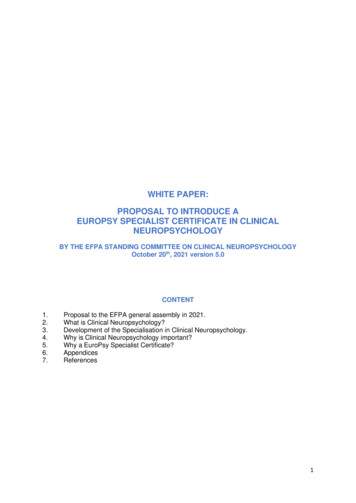
![Encyclopedia of Brazilian Jiu Jitsu: Volume 2 [Pdf] - Rigan Machado (2022)](/img/62/encyclopedia-20of-20brazilian-20jiu-20jitsu-20volume-202-20pdf.jpg)
